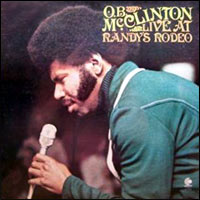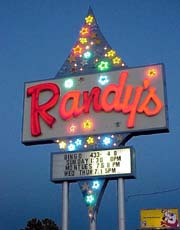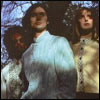Randy's Rodeo
music that rocks, rolls, swings, and twangs
| Artist Index | Song Index | Radio | Home |
|
Music Reviews Special Features Information Support Me |
home > features > this page
Later, of course, I learned about Randy's connection to the Sex Pistol's infamous, one-and-only American tour - the road trip from hell that gave the movie "Sid & Nancy" many of its finest moments. (Click here to view a detailed history of the performance and the tour.) As a teenager, I had missed out on what turned out to be a once-in-a-lifetime opportunity to see the Pistols at Dallas' Longhorn Ballroom on January 10, 1978. It was a lot easier to sneak into bars back then - sneaking out of the house was harder, actually - and I still regret my lack of will and foresight. Regardless, the San Antonio gig happened just two days before, and by all accounts, it was an incendiary, chaotic highlight of the tour. Johnny Moped, a punk rock historian, describes the Pistol's gig at Randy's thus:
Margaret Moser, an Austin Chronicle founder and staffer, was at the Randy's Rodeo Sex Pistol's show (click here to read her personal account) as well as other punk shows Randy's subsequently hosted. To her recollection, Randy's Rodeo had been almost exclusively a country bar," a real cowboy joint with real cowboys." The club had a simple floor plan - one big room with the stage set on the far wall from the door. According to Moser, the show was actually underwhelming - more a circus than a concert - but it had a far-reaching impact, kick starting Austin's now renowned music scene. Steve Earle, for one, credits the experience (peripherally, at least) as a major inspiration in a Rolling Stone interview with David Fricke:
Another email (1/25/03) from another reader (a certain Diane, who admitted "spent many Saturday nights boot-scooting across that dance floor") actually identified the bar girls in my iconographic picture (above). "The blonde's name was C.C. and her friend was Martha (at least, I think... something that started with an 'M'). Anyway, this photo was probably taken around 1966." Diane went on to confirm Randy's origins as a bowling alley (Bandera Bowling Lanes, according to her), and recalled that a number of big names played there after it was converted to into a country and western dance hall. In addition, local talent like George Chambers and the Country Gentleman also graced the stage at Randy's Rodeo. Diane recommended that I write to Don Strange to learn more about this period. Mr. Strange currently owns a catering business located across from the present-day Randy's Rodeo; back in the 60's, though, his business was barbecue, and he operated a rib joint of some renown on the same spot. Concerning the Bandera bowling alley, Don added that, "The bowling alley was built to be world-class, and it earned some national exposure. But the caliche-laden soil - along with the heat - caused the ground to shift, and the lanes never remained even. Our walls were always cracking and we eventually had to tear our building down and build a newer bigger one." Hence, the bowling alley failed, setting the stage for Randy's Rodeo.
In 1973, soul singer O.B. McClinton released an album, Live At Randy's Rodeo (photo above), on Enterprise Records, a Stax subsidiary - presumably recorded about the same time. McClinton, a minor figure at best, is best remembered for writing "You've Got My Mind Messed Up," one of James Carr's better songs, as well as tracks by Arthur Conley, Clarence Carter, Denise LaSalle, and the Staple Singers. Yet another reader, Mark Gierth, writes about a close encounter he had at Randy's Rodeo in 1976. Mark's father owned a rock and roll club called Charlie's Quarter Place in Universal City (just east of San Antonio). He did a lot of advertising on a radio station called KISS-FM, a hard rock outlet at the center of San Antonio's thriving heavy metal community. One of the DJs, Lou Roney, was tight with Mark's father:
And, that's about it for the history of Randy's Rodeo - pre-Sex Pistols, at any rate. Apparently, the club took a a sharp left turn after that watershed event. Margaret Moser recalls that, prior to the Pistols' show, Randy's booked mainly country & western acts, but thereafter hosted more rock shows. Squeeze played there in June, 1978 (just months after the Sex Pistols' show), and the Ramones blitzed Randy's stage in 1979. Reader Eric Nordin recalls:
Jim Loessberg, a steel guitar player and enthusiast (see above), saw this page and wrote in, adding this fascinating tidbit:
Another website quotes a San Antonio Express-News story about U2 playing to a small crowd at the venue on Valentine's Day, 1982, before they made it big in America (Moser attended that show, too). However, by the time of the U2 gig (by all accounts, another significant event for the Central Texas punk scene), the club had been renamed Cardi's and was presumably under new ownership. Moser remembers Cardi's as a fairly sleazy chain of 80's daiquiri bars. I found little else about the club's post-Pistols, rock-oriented period, though, until I found a web page that lists Randy's Rodeo on the 1999 tour itinerary of Slipknot and Coal Chamber. Gregg Allman also played there about the same time.
Still, at this point, the Sex Pistols gig would seem to be Randy's most credible claim to fame. The web is peppered with references to and descriptions of the event, and I have found numerous photographs of the actual show - Randy's Rodeo logo visible in many. Click here to read more and see the pictures. By the way, there was a Randy's Rodeo in New Jersey; it could still be there for all I know. I can only assume that it was named after (but has it has no other relation to) the Texas club due to the Sex Pistols' notoriety. A Beastie Boys show recorded at the Jersey club is very popular among bootleg traders.... If anyone reading this has anecdotes or information about Randy's Rodeo, I'd love to hear from you. I'll add your tales to this history and give you the credit! Drop me a line... Randy Anthony |
|
|||||||
Navigation Artist Index Song Index Randy's Radio Home Top Of Page Music Reviews Alternative Blues Books Christmas Classic Rock Country Jazz Lounge Special Features History Of Randy's Rodeo Sex Pistols Motown Records Halloween Valentine's Day Information About Me Feedback Links User's Guide Support Me Amazon iTunes Sheet Music Plus © 1999-2025 Randall Anthony, www.hipchristmas.com and www.randysrodeo.com |
|||||||||




 Around 1990, the club came roaring back to life as
Around 1990, the club came roaring back to life as 